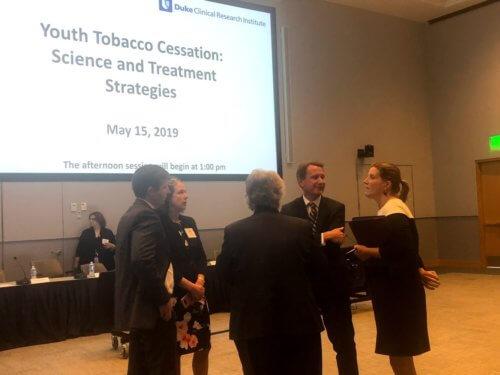
Recent media attention regarding the risks of vaping and e-cigarettes have led to many questions about the health impacts of using these products, particularly among young people. Findings from a recent workshop highlight why this issue is so complicated and what strategies may help to overcome the problem.
The DCRI and the Institute for Advanced Clinical Trials for Children (I-ACT) recently co-hosted a workshop to address youth tobacco addiction at the FDA headquarters in Bethesda, Maryland on May 15. Experts from around the country came together to discuss what is known about youth tobacco addiction, what methods to stop smoking are most effective among youth, and what evidence we still need to combat the epidemic of vaping among youth.
The Global Pediatric Trials Network (GPTN), led by the DCRI’s Michael Cohen-Wolkowiez, MD, PhD, and Christoph Hornik, MD, PhD, MPH, organized the workshop. DCRI project lead Rachel Olson collaborated with staff from I-ACT to facilitate the workshop, which had more than 900 registered attendees, both in person and via webcast.
The significance of the meeting was underscored by the attendance of Acting FDA Commissioner Ned Sharpless, MD, and Janet Woodcock, MD, Director of FDA’s Center for Drug Evaluation and Research (CDER), both of whom gave remarks that set the stage for the need to prevent e-cigarette use among youth and find successful strategies to treat those who are already addicted. The meeting organizers completed a full meeting summary, highlighting both key takeaway messages and the science supporting proposed next steps to address these issues.
Meeting key takeaways were:
- E-cigarette use among middle and high school students has increased significantly in the past several years. Between 2017 and 2018 alone, use among high school students increased 78 percent, from 11.7 to 20.8 percent– one in five students in this age group.
- There is evidence that e-cigarette use among youth has led to increase in the use of combustible cigarettes in this population.
- While the adverse effects of tobacco are well known, the health effects of e-cigarettes are less well known, although they can deliver much higher levels of nicotine than combustible cigarettes.
- A key barrier to e-cigarette cessation among youth is that they do not perceive e-cigarettes as a health risk, and many do not realize that e-cigarettes contain nicotine.
- There are only limited data on the effects of pharmacologic treatments for tobacco cessation among youth populations – and those data have shown little to no benefit. No studies among youth are known to have been conducted in the U.S. to determine the efficacy of pharmacologic therapies in treating e-cigarette addiction.
- Some behavioral strategies (e.g. social influence-oriented, cognitive-behavioral and motivation enhancement) for tobacco cessation have been shown to be effective, but these strategies have only begun to be applied to address e-cigarette addiction.
- Alarmingly, youth are progressing from first trial of e-cigarettes to daily use within just a few months. There is a need to explore the natural history of e-cigarette addiction in this age group to determine the best points in time to intervene.
- Adolescents are sensitive to stigma, which has contributed to the historical decline of combustible-cigarette smoking among youth. Because e-cigarettes are viewed positively by many youth (even seen as “cool”), new approaches will be needed to both prevent e-cigarette use in this age group and convince current users to quit.
- Given the significant and continued rise in e-cigarette use among youth, it is critical to identify cessation therapies that will be effective against this new type of addiction.
The full presentations and meeting summary are available here.